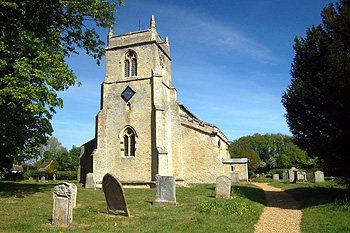Early Education in Shelton

The church from the south-west, May 2011
Volume 81 published by Bedfordshire Historical Records Society (2002) is a series of episcopal visitations undertaken in the first twenty years of the 18th century, edited by former County Archivist Patricia Bell. At each visitation a list of questions was sent out in advance, one of which enquired about the provision of schools in each parish. In 1706 the return stated: “There is no Lecture, Schole [sic], Almes-house [sic], or Hospital endowed in this parish”.
This did not mean that Shelton children went untaught. The return for the same date for Dean states: “There is a Charitie School for 20 poor Boys whose Parents are not worth £100. Ten of them of Dean, Five of Shelton in this County, and five of Swineshead in the County of Huntingdon. It was founded by Joseph Neale of London Esquire A. D. 1702. the Endowment is of certain lands in the county of Huntingdon now let for about £24 per Annum”.
In 1709 the return for Shelton read: “No public or charity schole [sic]”. In 1717 the return stated: “They have the priviledge of sending their children to Yelden”. In 1720 the return stated: “We have no Publick [sic] or Charity school in our Parish”.
A stray list of children attending Shelton Sunday school in May and June 1808 has survived in the Wade Gery collection [ref: WG1111]. In those days a Sunday school was just that, a school which met on a Sunday, usually in the church or nonconformist chapel or other similar building, teaching more than the religious topics with which they are associated today. The list of names is as follows:
- Elizabeth Button;
- Susan Button;
- John Button;
- Hannah Briggs;
- Elizabeth Bettles;
- Richard Bettles;
- William Bettles;
- Elizabeth Burton;
- Reuben Annis;
- George Annis;
- Sarah Annis;
- Hannah Gore;
- William Gore;
- John Lawrence;
- Reuben Lawrence;
- George Lawrence;
- Jeremiah Lawrence;
- Mary Lawrence;
- William Miller;
- Elizabeth Miller;
- Robert Kirk;
- John Baker.
In 1818 a Select Committee was established to enquire into educational provision for the poor. This was no doubt prompted, in part, by the recent foundation of two societies promoting education and specifically the building of schools. The Society for Promoting the Lancasterian System for the Education of the Poor was established in 1808 promoting schools run along the lines pioneered by Joseph Lancaster, who had himself copied those of Dr. Andrew Bell, in which older children taught their younger fellows. The Society was renamed the British and Foreign School Society in 1814. It was supported by a number of prominent nonconformists, Lancaster himself was a Quaker, and sought to teach a non-sectarian curriculum. In answer to this perceived nonconformist takeover of local education the National Society was formed in 1811 to encourage the teaching of poor children along Anglican lines, including the catechism. The Select Committee sent a questionnaire to all parishes in the country asking for: particulars relating to endowments for the education of children; other educational institutions; observations of parish needs etc. The return for Shelton stated that there was no daily school but a Sunday school “supported by inhabitants, in which from 15 to 20 children are taught. The return noted: “The parish have the privilege of sending 5 boys to the endowed school in the adjoining parish of Dean”.
In the country generally the number of schools built continued to grow over the next fifteen years so that by 1833 the government agreed to supplement the work of the two societies, and local benefactors, by making £20,000 per annum available in grants to help build schools. It also prompted another questionnaire to be sent to each parish in England asking for details of local educational provision. The return for Shelton stated: “One Sunday School, in which 13 males and 16 females are instructed; this is wholly supported by the Rector. The inhabitants of this parish have the privilege of sending 5 boys to an endowed School at Dean”.
The next national enquiry was in 1846/7 when the Church of England made an enquiry as to all its church schools. This was against the background of a new Whig government which championed secular education and the increasing importance of nonconformists, particularly Wesleyan Methodist, and Roman Catholics in providing schools. The return for Shelton listed a Sunday school for 16 boys and 14 girls. It noted: “There is an endowed school in the adjoining parish of Dean, to which the parish has the right of sending 5 boys. There is also a dame’s school containing twelve boys supported by the Rector”.
The first Education Act was passed in 1870 (more correctly it was known as the Elementary Education Act). It was a milestone in the provision of education in Britain demonstrating central government's unequivocal support for education of all classes across the country. It also sought to secularise education by allowing the creation of School Boards. These were groups of representatives, elected by the local ratepayers and the Board had the powers to raise funds to form a local rate to support local education, build and run schools, pay the fees of the poorest children, make local school attendance compulsory between the ages of 5 and 13 and could even support local church schools, though in practice they replaced them, turning them into Board run schools (known as Board Schools). Naturally, and luckily for local historians, the Act required a questionnaire of local schools in 1870. The return for Shelton was included in that for Dean and stated that there was no efficient school in either place and that a school for 81 boys and girls and 60 infants was required at Upper Dean. Shelton school was built in 1877.
 The former school, May 2011
The former school, May 2011